Raindrop Size Distribution Characteristics of the Precipitation Process of 2216 Typhoon “Noru” in the Xisha Region
Abstract
1. Introduction
2. Materials and Methods
3. Reliability of Raindrop Spectra Data
4. Typhoon Overview and Weather Background
5. Analysis of Raindrop Spectral Variations in Typhoon “Noru”
5.1. Temporal Variation in Raindrop Spectra
5.2. Mean Raindrop Size Distribution Characteristics and Gamma Fitting Analysis
5.3. Analysis of the Z-R Relationship and μ-Λ Relationship in Raindrop Size Distribution
6. Conclusions
- When precipitation is primarily composed of small- and medium-sized raindrops, the rainfall intensity is relatively low. When larger raindrops increase in number, the rainfall intensity grows. Stronger precipitation corresponds to a higher number of large raindrops. There is no significant correlation between raindrop size and quantity and the intensity of the typhoon. The rainfall intensity () is primarily proportional to the mean number concentration () and the mean raindrop mass diameter (). The influence of the mean raindrop mass diameter () on the rainfall intensity () is greater than that of the mean number concentration ().
- Due to the interaction of cold and warm air masses, the precipitation during Typhoon “Noru” features high raindrop concentrations and large diameters. While the raindrop diameters suggest characteristics of a temperate typhoon, the overall composition consisting mainly of small- to medium-sized raindrops indicates tropical typhoon features, with a lower proportion of large raindrops. Additionally, the presence of more raindrops and larger raindrop diameters may be associated with the underlying surface being oceanic rather than terrestrial.
- The inner and outer rainbands of Typhoon “Noru” exhibit similar precipitation types, characterized by a unimodal raindrop spectrum with a narrow width. The precipitation process is dominated by small- and medium-sized raindrops, indicative of stratiform-mixed cloud precipitation, with a significant proportion of stratiform cloud precipitation that fits poorly with the Gamma distribution. Strong echo intensities often correlate with high raindrop concentrations and larger particle sizes.
- The Z-R relationship for Typhoon Noru’s precipitation shows a lower coefficient compared to the standard Z-R relationship, with a consistent exponent, resulting in the radar underestimation of precipitation. Based on previous studies, comparative analysis suggests that variations in raindrop diameter under different precipitation characteristics of typhoons significantly influence the Z-R relationship, with the contribution of raindrop diameter being greater than that of raindrop quantity. The - relationship is , which can be integrated into forecasting models to refine the Z-R relationship, making it essential to conduct comparative studies on the Z-R relationship for similar path typhoons to improve radar estimates of typhoon precipitation accuracy.
Author Contributions
Funding
Data Availability Statement
Conflicts of Interest
References
- Chen, L.; Meng, Z.; Cong, C. A summary of the study on the falling area of typhoon rainstorm. J. Mar. Meteorol. 2017, 37, 1–7. [Google Scholar] [CrossRef]
- Choi, J.W.; Cha, Y. Tropical cyclone occurrence probability forecasting model in the western north pacific. Trop. Cyclone Res. Rev. 2016, 5, 23–31. [Google Scholar]
- Minghua, S.; Yihong, D.; Jianrong, Z.; Hui, W.U.; Jin, Z.; Wei, H. Experimental study on the prediction of typhoon “Meihua” using a mesoscale air sea coupling model. Acta Oceanol. Sin. 2014, 33, 123. [Google Scholar]
- Lin, C.; Linli, Z.; Nan, L.; Wenzhe, W. Analysis of Circulation Characteristics and Causes of Continuous Rainy Weather under the Influence of Typhoon Lionrock. Jilin Agric. Second. Half Mon. 2018, 3. Available online: https://qikan.cqvip.com/Qikan/Article/Detail?id=675921785 (accessed on 10 August 2024).
- Lin, Y.; Liu, A. Relationship between typhoon heavy rainstorm in Fujian and circulation situation field. In Proceedings of the 2008 Annual Meeting of the Chinese Meteorological Society, Changsha, China, 18–20 November 2008. [Google Scholar]
- Shen, Y.; Li, Y.; Fan, K. Evaluation of the effectiveness of radar precipitation estimation products during the 2021 Meiyu and typhoon periods in Zhejiang Province. Meteorol. Zhejiang Prov. 2023, 44, 17–22. [Google Scholar]
- Xu, L.; Yu, Z.; Qiu, J.; Li, Y.; Wu, M. Comparative analysis of multimodal precipitation forecast evaluation before and after the landfall of super typhoon “Lekima”. Meteorol. Sci. 2020, 40, 12. [Google Scholar]
- Sai, C.; Yafei, Z.; Jia, G.; Yunping, C.; Lin, C. Research on the correction of weather radar Z-R relationship using raindrop spectrum. Strait Sci. 2021, 6. [Google Scholar]
- Zhang, Q.; Liu. D.; Lv, X.; Liu, Z. Characteristics of raindrop spectrum and Z-R relationship of different types of rainstorm in Huaibei area. J. Meteorol. 2022, 80, 967–985. [Google Scholar]
- Yuxin, Z.; Huibang, H.; Shiyu, G.; Jianbing, T.; Wenting, T. Raindrop spectrum characteristics and Z-R relationship of different precipitation cloud systems in summer at the southern foot of Qilian Mountains. Arid. Zone Res. 2021, 38, 10. [Google Scholar]
- Xie, Y.; Chen, Z.; Dai, J.; Hu, P. Analysis of Raindrop Spectrum Characteristics of Several Types of Heavy Precipitation in Shanghai Area. Meteorol. Sci. 2015, 35, 353–361. [Google Scholar]
- Yang, J.; Chen, B.; Han, Y.; Li, P. Statistical characteristics of raindrop spectra in different regions of Shanxi Province. Meteorol. Sci. 2016, 36, 88–95. [Google Scholar]
- Zhao, C.; Zhang, L.; Liang, H.; Li, L. Analysis of Raindrop Spectrum Characteristics in Summer in Mountainous and Plain Areas of Beijing. Meteorol. Phenom. 2021, 47, 830–842. [Google Scholar]
- Ulbrich, C.W.; Lee, L.G. Rainfall Characteristics Associated with the Remnants of Tropical Storm Helene in Upstate South Carolina. Weather. Forecast. 2001, 17, 1257–1267. [Google Scholar] [CrossRef]
- Wang, J.; Zheng, L.; Wang, H.; Liu, C. Statistical characteristics and regional differences of raindrop spectra of six typhoon storms in shandong province. J. Appl. Meteorol. 2023, 34, 475–488. [Google Scholar]
- Zhu, H.; Yang, Z.; Wang, D.; Yu, J. Comparative analysis of precipitation characteristics of two typhoons entering inland areas. J. Meteorol. 2019, 77, 14. [Google Scholar]
- Shen, G.; Gao, A.; Li, J. Application of Raindrop Spectrum and Dual Polarization Radar Data in a Heavy Precipitation Process. Meteorological 2021, 47, 737–745. [Google Scholar]
- Feng, W.; Shi, L.; Wang, Z.; Huang, X.; Yang, L.; Zhang, L. Application of Raindrop Spectrometer Data in Rainfall Estimation of Typhoon Wipha. Meteorological 2021, 47, 389–397. [Google Scholar]
- Tokay, A.; Bashor, P.G.; Habib, E.; Kasparis, T. Raindrop size distribution measurements in tropical cyclones. Mon. Weather. Rev. 2008, 136, 1669–1685. [Google Scholar] [CrossRef]
- Okachi, H.; Yamada, T.J.; Baba, Y.; Kubo, T. Characteristics of Rain and Sea Spray Droplet Size Distribution at a Marine Tower. Atmosphere 2020, 11, 1210. [Google Scholar] [CrossRef]
- Lyu, J.J.; Xiao, H.W.; Du, Y.C.; Sha, L.N.; Deng, Y.Q.; Jia, W.K.; Niu, S.J.; Zhou, Y.; Pang, G.Q. Variations of Raindrop Size Distribution and Radar Retrieval in Outer Rainbands of Typhoon Mangkhut (2018). J. Meteorol. Res. 2022, 36, 500–519. [Google Scholar] [CrossRef]
- Suh, S.H.; Kim, H.J.; You, C.H.; Lee, D.I. Raindrop size distribution of rainfall system indirectly affected by Typhoon Kong-Rey (2018) passed through the southern parts of Korea. Atmos. Res. 2021, 257, 105561. [Google Scholar] [CrossRef]
- Jin, Q.; Yuan, Y.; Liu, H.; Shi, C.; Li, J. Analysis of Raindrop Spectrum Characteristics between Jianghuai in Summer. J. Meteorol. 2015, 73, 11. [Google Scholar]
- Chen, B.J.; Wang, Y.; Ming, J. Microphysical Characteristics of The Raindrop Size Distribution in Typhoon Morakot (2009). J. Trop. Meteorol. 2012, 18, 10. [Google Scholar]
- Battaglia, A.; Rustemeier, E.; Tokay, A.; Blahak, U.; Simmer, C. PARSIVEL Snow Observations: A Critical Assessment. J. Atmos. Ocean. Technol. 2010, 27, 333–344. [Google Scholar] [CrossRef]
- Niu, S.; Jia, X.; Sang, J.; Liu, X.; Lu, C.; Liu, Y. Distributions of Raindrop Sizes and Fall Velocities in a Semiarid Plateau Climate: Convective versus Stratiform Rains. J. Appl. Meteorol. Climatol. 2010, 49, 632–645. [Google Scholar] [CrossRef]
- Li, L.; Sun, H.; Yang, M.; Du, C.; Fan, X.; Lu, Y.; Yin, J. Raindrop spectrum quality control method based on speed and quantity thresholds. Meteorological 2022, 48, 8. [Google Scholar]
- Tong, L.; Kang, L.; Penglei, F. Observation and Study on the Characteristics of Wind and Rain Droplet Spectra on the Landing Platform [EB/OL]; China Science and Technology Paper Online: Beijing, China, 2020. [Google Scholar]
- Thurai, M.; Bringi, V.N.; May, P.T. Drop Shape Studies in Rain Using 2-D Video Disdrometer and Dual-Wavelength, Polarimetric Cp 2 Radar Measurements in South-East Queensland, Australia. 2009. Available online: https://ams.confex.com/ams/34Radar/webprogram/Paper155443.html (accessed on 10 August 2024).
- Zhang, G.; Vivekanandan, J.; Brandes, E.A.; Meneghini, R.; Kozu, T. The shape–slope relation in observed gamma raindrop size distributions: Statistical error or useful information? J. Atmos. Oceanic Technol. 2003, 20, 1106–1119. [Google Scholar] [CrossRef]
- Chang, W.; Wang, T.C.; Lin, P. Characteristics of the raindrop size distribution and drop shape relation in typhoon systems in the western pacific from the 2d video disdrometer and ncu c-band polarimetric radar. J. Atmos. Oceanic Technol. 2009, 26, 1973–1993. [Google Scholar] [CrossRef]


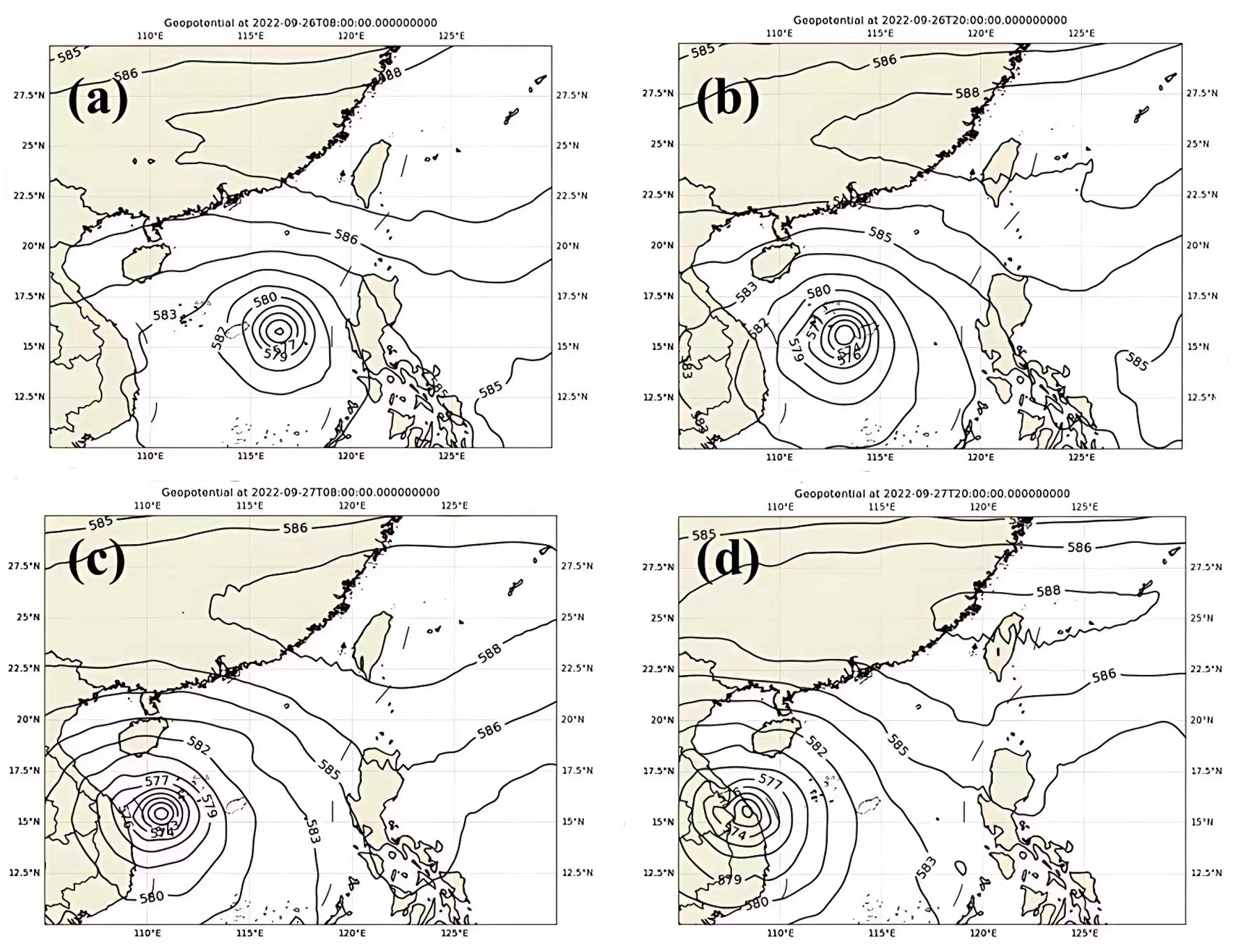
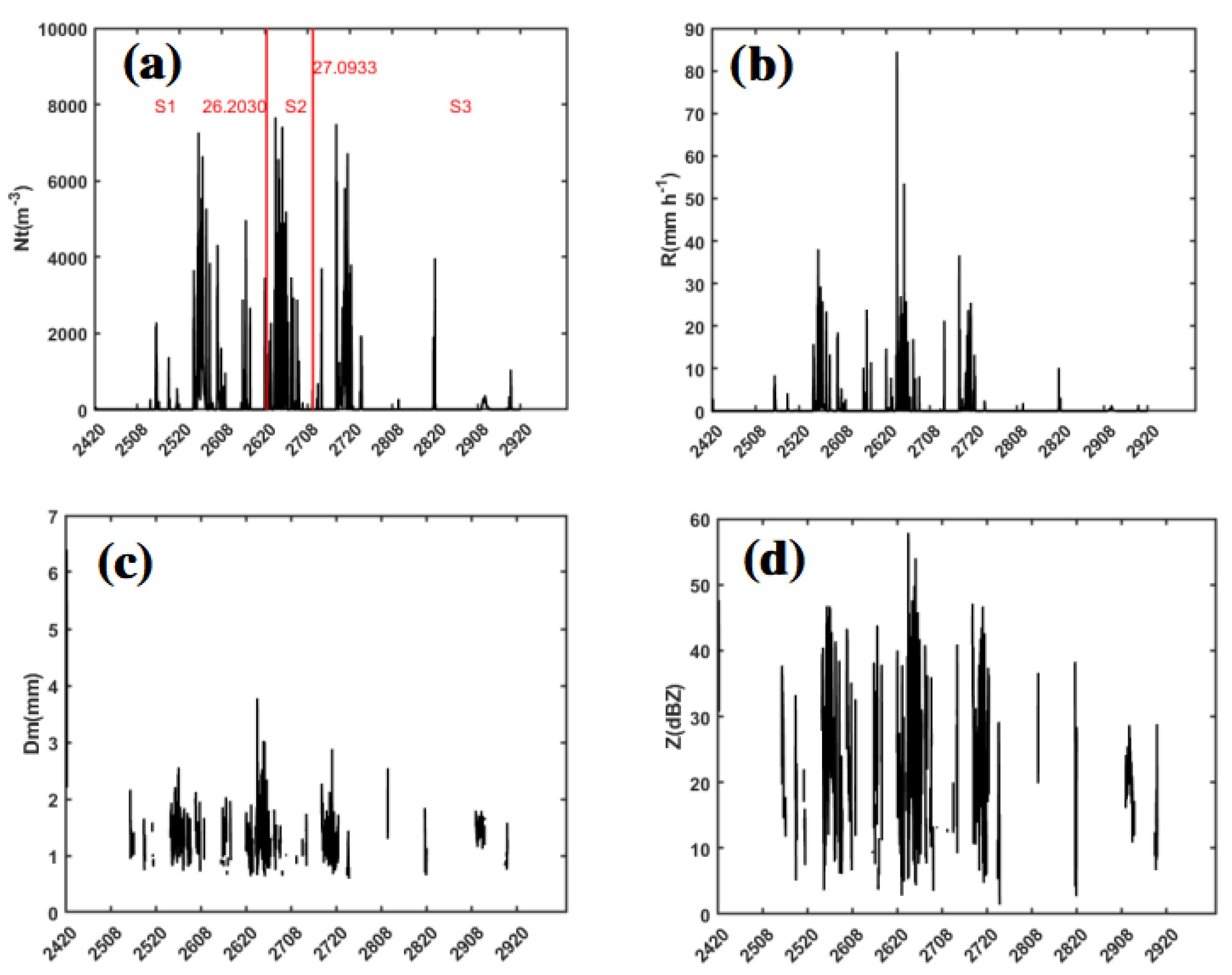
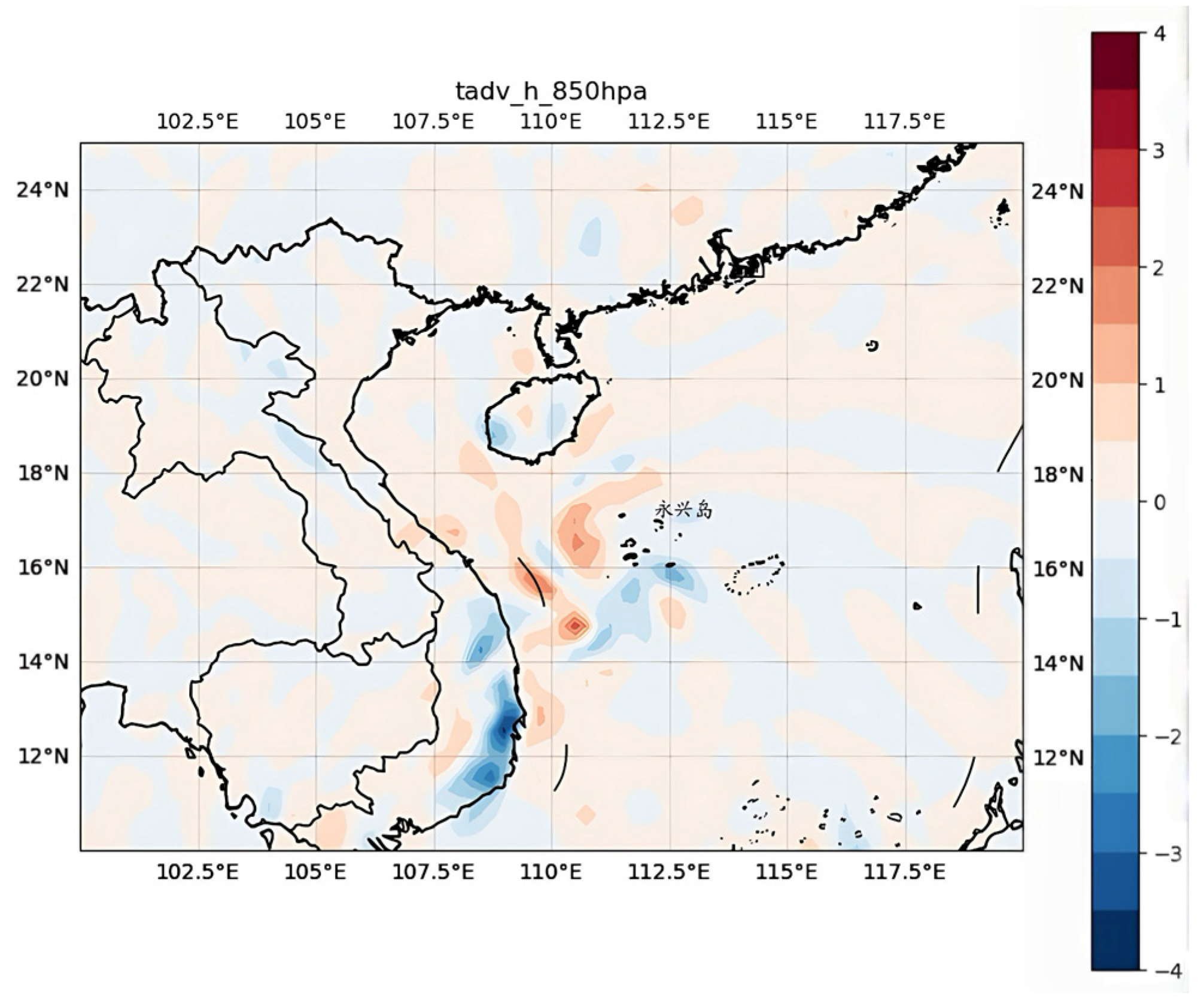
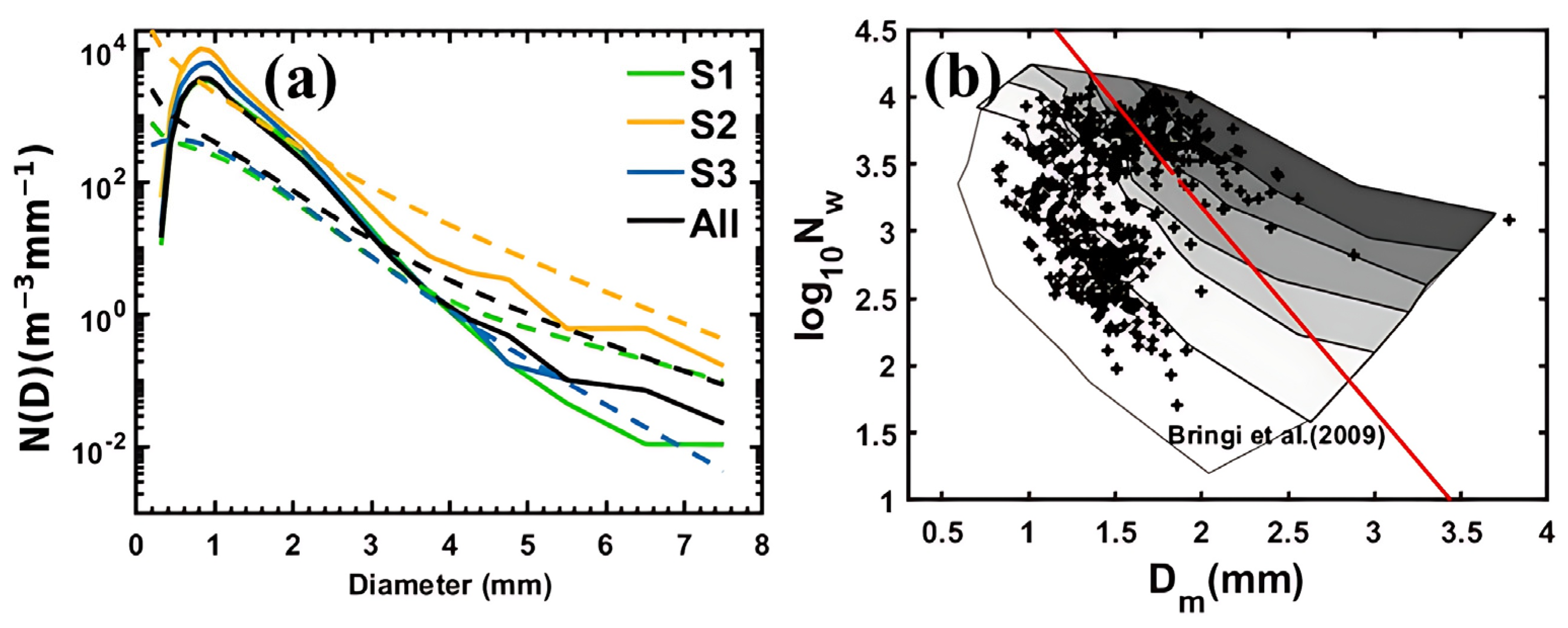
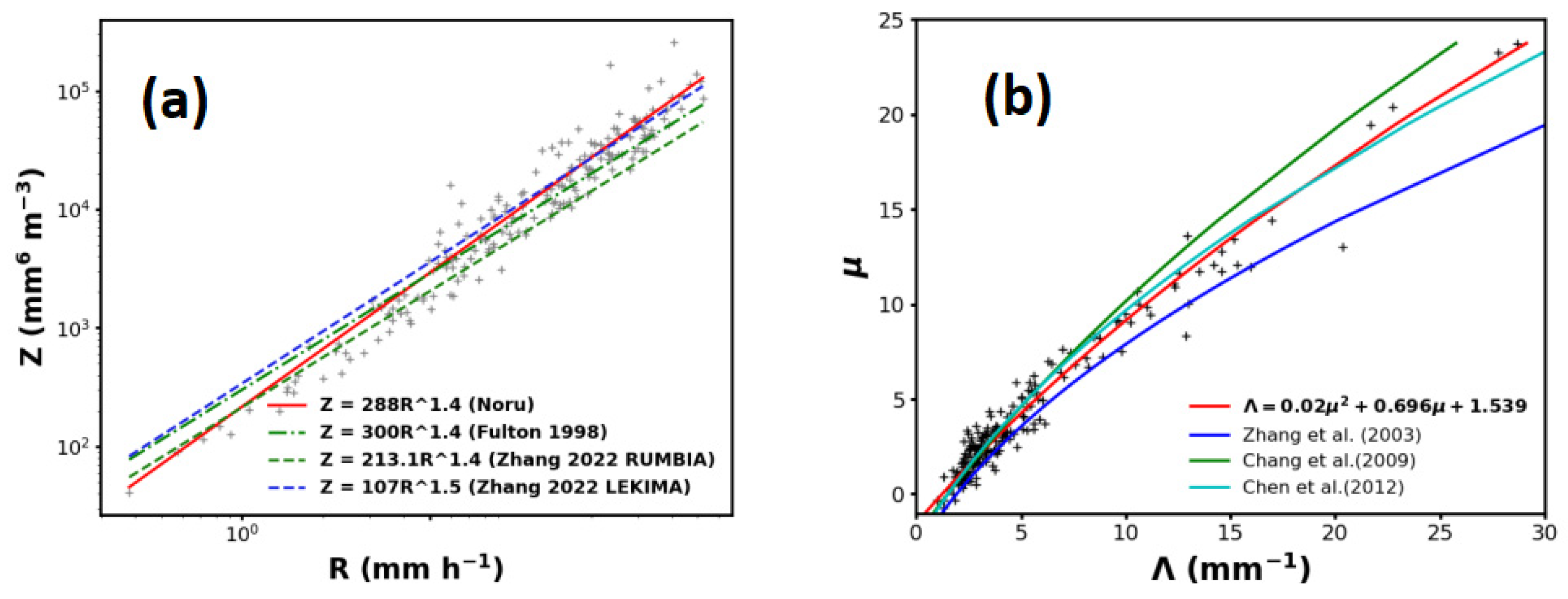
| Typhoon | Intensity at Landfall (Through) | Different Stages | Mean Concentration (Nt/mm−1·m−3) | Mean Raindrop Diameter (Dm/mm) | Rainfall Intensity (R/mm·h−1) |
|---|---|---|---|---|---|
| Noru | Level 17, Super typhoon | S2 (heavy precipitation) | 1457.2 | 1.56 | 19.07 |
| S1, S3 (weak precipitation) | 1240.7 | 1.15 | 14.98 | ||
| LEKIMA | Level 16, Super typhoon | Heavy precipitation | 686.0 | 0.98 | 13.10 |
| Weak precipitation | 259.8 | 0.80 | 2.60 | ||
| RUMBIA | Level 10, Severe tropical storm | Heavy precipitation | 931.0 | 0.92 | 13.76 |
| Weak precipitation | 1161.0 | 0.60 | 2.52 |
Disclaimer/Publisher’s Note: The statements, opinions and data contained in all publications are solely those of the individual author(s) and contributor(s) and not of MDPI and/or the editor(s). MDPI and/or the editor(s) disclaim responsibility for any injury to people or property resulting from any ideas, methods, instructions or products referred to in the content. |
© 2024 by the authors. Licensee MDPI, Basel, Switzerland. This article is an open access article distributed under the terms and conditions of the Creative Commons Attribution (CC BY) license (https://creativecommons.org/licenses/by/4.0/).
Share and Cite
Wang, G.; Li, L.; Huang, C.; Zhang, L. Raindrop Size Distribution Characteristics of the Precipitation Process of 2216 Typhoon “Noru” in the Xisha Region. Water 2024, 16, 2630. https://doi.org/10.3390/w16182630
Wang G, Li L, Huang C, Zhang L. Raindrop Size Distribution Characteristics of the Precipitation Process of 2216 Typhoon “Noru” in the Xisha Region. Water. 2024; 16(18):2630. https://doi.org/10.3390/w16182630
Chicago/Turabian StyleWang, Guozhang, Lei Li, Chaoying Huang, and Lili Zhang. 2024. "Raindrop Size Distribution Characteristics of the Precipitation Process of 2216 Typhoon “Noru” in the Xisha Region" Water 16, no. 18: 2630. https://doi.org/10.3390/w16182630
APA StyleWang, G., Li, L., Huang, C., & Zhang, L. (2024). Raindrop Size Distribution Characteristics of the Precipitation Process of 2216 Typhoon “Noru” in the Xisha Region. Water, 16(18), 2630. https://doi.org/10.3390/w16182630







